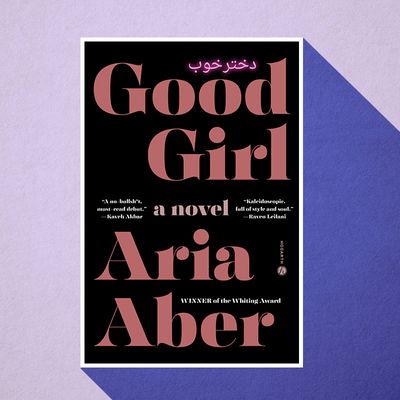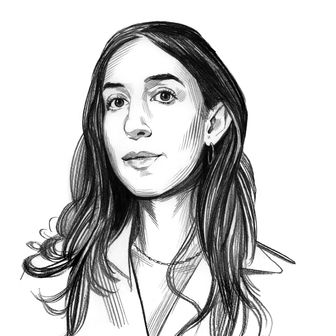
Much to the chagrin of her widowed father, Nila Haddadi is no good girl. The narrator in Aria Aber’s debut novel rebels in all the ways that a 19-year-old born to Afghan refugees in Berlin can: She is rarely home, skips class, takes drugs, has sex, dreams of becoming a photographer, and frequents a nightclub she calls the Bunker, a recognizable stand-in for Berghain. There, she meets Marlowe, a 36-year-old American novelist in his flop era with several red flags: He is mostly unemployed, spends nights inhaling speed at the club, and habitually cheats on the younger women he dates with even younger ones. But Nila can’t help herself. “My desire, though nascent, already felt so profound that it seemed close to hatred,” she says. She tells him she’s from Berlin, but he pushes for the type of answer that would account for her “dark and aquiline face” and “unruly curls,” so she lies and says her parents are Greek.
Throughout Good Girl, Nila capitalizes on the ignorance of the white Germans around her to pass as anything but Afghan. “Sometimes I lied that I was Colombian,” she says, “sometimes I was from Spain or Israel.” This evasiveness appears to be inherited; her mother, she recalls, once claimed to be French. It takes a village to learn to hate yourself, and no one knows how tangled up love and shame can be better than a child raised, like Nila, “in the shadow of a fairer, better life” that her parents, doctors back in Afghanistan, had to suddenly abandon. At first glance, Aber’s book has many traits of the kind of jaded, self-aware, and sexed-up millennial novel we’ve seen before. But Good Girl, an ambitious, often beautiful, yet bloated debut set against the backdrop of Germany’s growing anti-immigrant sentiment, wrestles with the knot of Nila’s self-loathing without ever quite undoing it.
Aber is an award-winning poet who writes in her third language. Like Nila, she was born in Germany to refugees from Afghanistan and grew up speaking Farsi and German. Her first poetry collection, 2019’s Hard Damage, is a controlled and imaginative exploration of the effect of exile on the self. As Aber said in an interview in 2020, “In my teens and early 20s, I went through a very hedonistic and self-destructive phase. I grappled with being Afghan, with being from a different culture than most of my friends at the time.” Good Girl arrives over a year into Israel’s relentless siege of Gaza, which has brought the West’s apathy toward Muslim people into sharp relief. Its narrator is of both worlds and neither, and the self-other divide lives inside her.
Good Girl captures the ache of Muslim girlhood and the vertigo of never feeling quite at home. The story alternates between Nila’s fascination with Marlowe and his crew and memories of “the rotten pain” of her childhood. Nila grew up “a small, wide-eyed rat” in Gropiusstadt, a poor neighborhood in the south of Neukölln that she describes as “a nightmare of brutalist concrete and unemployment rates.” Bugs flee into the corners of every room, and neo-Nazis live next door to her family, who take on the qualities of vermin too: “Like cockroaches and ants, we scurried through our district.” Young Nila contends with subtle racism from her peers, especially following 9/11; the doomed endeavor to bridge the cultural divide between herself and her mostly unassimilated family members; and her mother’s death. Like many Muslim daughters before her, she “wanted what my male cousins had, which was the privilege to be unbounded by an ancient idea of honor and purity.”
Aber is skilled at creating a charged sense of atmosphere and mood, but the novel tends to rehash the same narrative associations without deepening or complicating them. The image of Nila’s apartment building becomes a catchall for her family, growing up in poverty, and being of Muslim background in a country where mosques are set ablaze and brown people are victims of hate crimes. As she scuttles between clubs and her home in Gropiusstadt, Nila projects her self-loathing onto people who look like her. In her eyes, Arab teens congregate “like a lump of bad luck,” and she leaves an Afghan bakery “blistering with hatred.” Meanwhile, she admires her nearly indistinguishable white friends. Aber uses Nila’s increasingly toxic relationship with Marlowe, nightlife, and drugs — which appear so often in the story that they become boring — as shorthand for the promise of a life of art and nonconformity. When Marlowe’s gig with an architecture firm takes them to the castle of Rilke’s Duino Elegies, it dawns on Nila that Marlowe had been “my ticket into everything, every building I had seen, and the possibility to shed my own building from me.” Upon their return to Berlin, the couple hail a taxi and the driver turns out to be Nila’s uncle — a coincidence that falls just short of believable. Her uncle tells Marlowe to scram, then drives her back to “those buildings, the sight of which made me feel sick, as if I were being punched in the chest,” where her father grounds her for having a boyfriend.
Woe is Nila, who is trying so hard to find herself that she just might get lost. Nila’s retrospective narration, coming over a decade after her first encounter with Marlowe, comments at times on her own lack of understanding and shows a passing awareness of her younger self’s naïveté. Yet we might expect that ten-plus years would have made her wiser about her motivations and more compassionate toward her family, if not herself. Nila’s self-deprecation makes an unsatisfying substitute for enlightenment, and without the dynamism that could spring from the push and pull between two versions of the self, the story feels a little too much like the photos she takes: static.
In an essay about the limits of self-awareness in Sally Rooney’s millennial Ur-texts Conversations With Friends and Normal People, Katy Waldman argues that “mocking your emotions, or expressing doubt or shame about them, doesn’t negate those emotions.” The problem with today’s writers of the bildungsroman — or of the Künstlerroman, which focuses on an artist’s development — is they “halt the journey midway through, leaving their characters tuned to problems but unable to solve them,” she writes. “The self-scrutiny and self-recrimination remain; the maturity is optional.” That is certainly one way to describe Good Girl, yet another novel that ends, like Normal People, with a main character planning to pursue a graduate art degree abroad rather than toughing it out at home.
In the decade since, has Nila left Germany and become an artist? Aber doesn’t tell us. Nila’s fuzzy retrospection is especially frustrating in moments featuring her toxic relationship with Marlowe. Over time, he becomes physically violent. What begins as pinches and bruises that Nila cherishes “with a misplaced tenderness” erupts in an excruciating scene set at a buttoned-up fundraising event for dogs in Afghanistan. Nila, obviously triggered but unable to say why — she’s still undercover as a Greek woman — breaks some things, insults Marlowe, and storms out. She is shocked when he actually hits her, but she wants to “see how far he would go” and goads him into doing worse. Nila eventually moves in with him anyway. The novel’s many uncomfortable sex scenes reveal the bedroom as the place where women negotiate power with men and where even consensual encounters tip toward imbalance but don’t add to these familiar observations. After a while, Good Girl ’s title starts to sound less like a reference to the dokhtare khub Nila’s parents are imploring her to be and more like one to the doggedly “loyal stray,” as she later describes herself.
Aber’s book is successful in showing that self-hatred is the fruit not of a few particular traumas but rather of a hostile environment’s erosive drip on the psyche. But Good Girl doesn’t liberate Nila from herself, and the novel fails to interrogate Nila’s internalized racism in a satisfying way. It takes nothing less than a close-to-home hate crime — which functions as a kind of climax in an otherwise overlong and loosely plotted novel — for Nila to finally begin to sympathize with her father’s “constant alienation” in Germany. A shooting at the neighborhood bakery that kills its Afghan owners turns out to be the latest in a yearslong series of murders committed by neo-Nazis, which the state had blamed on the very immigrant communities that were targeted. Aber bases these attacks on real killings that occurred throughout Germany in the aughts, but she takes some liberties: In real life, the victims were all Turkish, Greek, or German.
Good Girl is best read as a portrait of Berlin and the rise of its anti-immigrant sentiment as seen through the eyes of a grieving young Afghan woman. Aber conjures place with great specificity; her descriptions feel alive. But Good Girl is also stuffed with tropes of a certain kind of millennial novel: A disaffected but self-aware young woman yearns to become an artist. She is convinced she’s ugly but is systematically told she’s beautiful. Her friends vaguely discuss gentrification and Marxism. She’s, as Noor Qassim put it for The Drift, “a bisexual woman besotted with a man she might otherwise find objectionable.” He’s older, appears at first glance to have an enviable life, and hits her during sex, which she’s mostly into. But what distinguishes Good Girl from what Qassim diagnosed as the masochistic “Millennial Sex Novel” or Namwali Serpell’s “remaster novels” are its more overtly political concerns. Aber ingests the millennial playbook and spits out something that happens to be more interesting. At one point, when Nila’s crew discusses a recent train-station bombing, Marlowe asserts that “Nothing bad is ever going to happen in Germany; this country has itself under control.” Anti-Muslim incidents have more than doubled there since October 7, 2023. What could be timelier than a Muslim party girl reckoning with her identity while her world tells her brown lives don’t matter?


